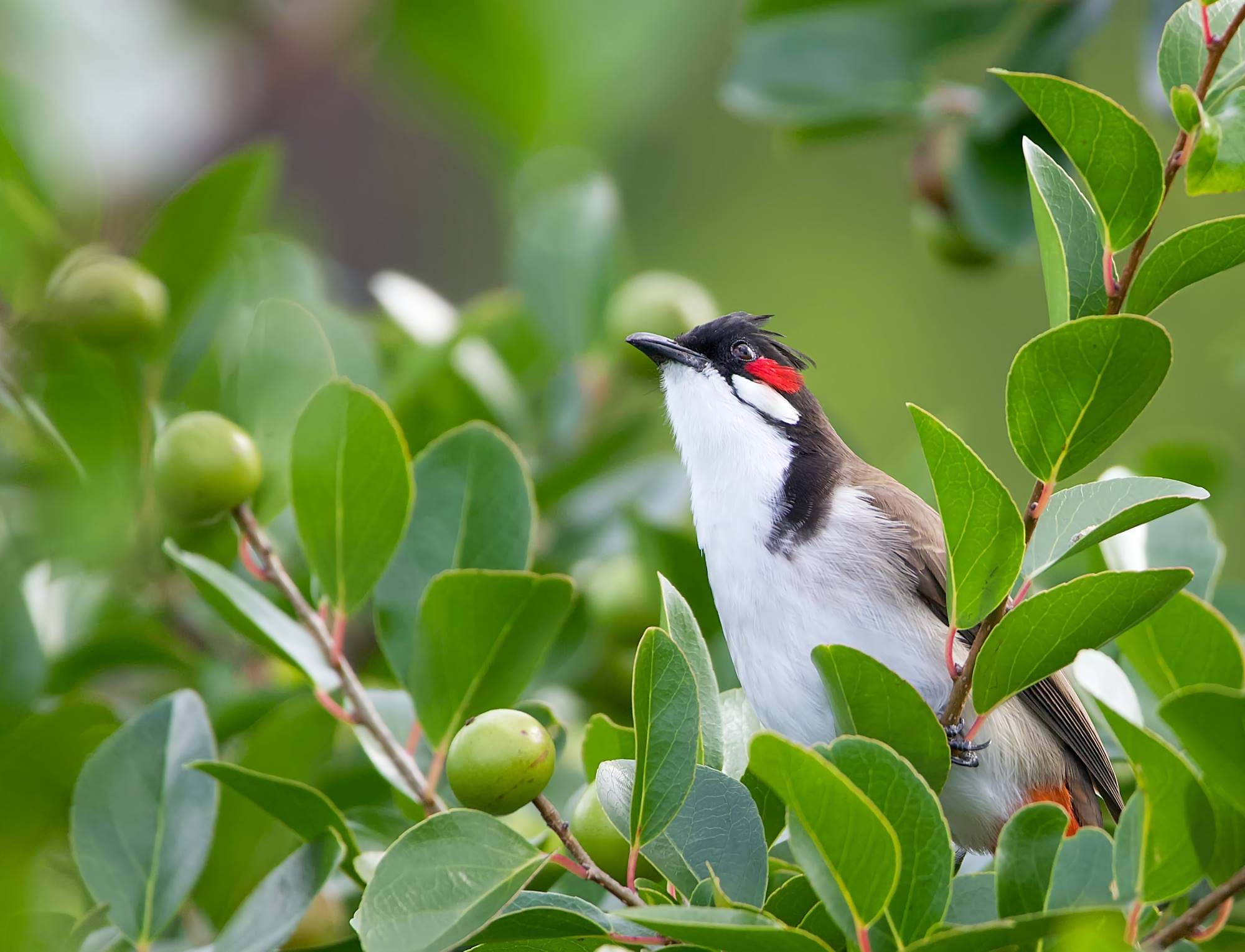The Birdwatcher's Guide to Mauritius
24 September 2025
Editor’s Note (2025 Update):
This article has been refreshed with the latest conservation updates on Mauritius’ endemic bird species. Their statuses and populations have evolved thanks to ongoing protection efforts.
Tucked within the lush forests and national parks of Mauritius are some of the rarest birds on Earth — species found nowhere else but here. Thankfully, decades of conservation have ensured that these remarkable birds have not shared the fate of the island’s most famous lost species: the dodo. For birdwatchers, this means that alongside sunsets and sea views, unforgettable encounters with endemic species may be waiting just around the corner. Many of them can be seen in Black River Gorges National Park and in restored habitats such as Ebony Forest.
Here are seven of the incredible endemic birds you have the chance of sighting on a magical trip to Mauritius:
1. Mauritius Kestrel
The amazing Mauritius kestrel, one of the world’s rarest birds, came very close to extinction at one point (in 1974 when there were only four individual birds of this species left in the world, it was actually deemed the rarest bird in the world), but thankfully the Durrell Wildlife Conservation Trust (who have done extensive conservation work in Mauritius) came to their aid and were able to perform a miracle by saving the species, which is said to be one of the most outstanding conservation successes ever. While these birds can now be found in captive collections that form part of conservation efforts, they can also be found in their natural habitat where they are thriving and breeding successfully.
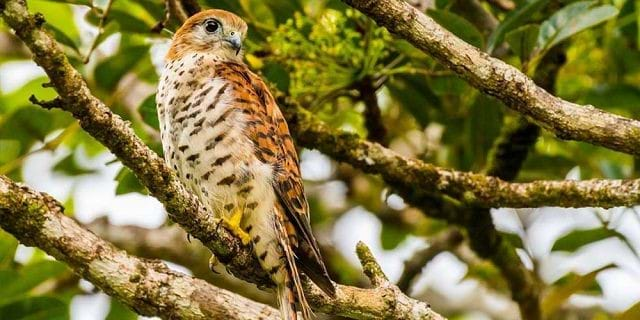
This bird of prey forms part of the Falconidae family and is found in the southwestern plateau of Mauritius where they can be seen in forests, along the cliffs or in ravines. Considered to be the most distinct of the Indian Ocean kestrels, this gorgeous bird is a relatively small species that generally reaches between 26cm-30.5cm and weighs up to 250g, with the males being slightly smaller than the females. Interestingly, both the female and the male are very similar in appearance (except for the aforementioned difference) and they have characteristically short wings, long tails and legs with short talons. The upper body is a deep chestnut with black markings while the underside is a creamy white with dark sports. The last remaining raptor in Mauritius, it’s vital that these rare and exquisite birds are well looked after or they could risk being on the brink of extinction once more.
Today, the Mauritius kestrel is still listed as Endangered with fewer than 400 mature individuals, but remains one of the greatest conservation success stories. In 2022 it was officially declared the national bird of Mauritius, and its nesting sites continue to be monitored closely every year.
2. Pink Pigeon
The wonderfully exotic and incredibly rare pink pigeon is a type of pigeon found in the Columbidae family endemic to Mauritius. Much like the Mauritius kestrels, these wonderfully unique birds came close to extinction in the 1990s (there were only 10 individuals of this species left in 1991) and remain incredibly rare today. Their survival today is due to the Mauritian Wildlife Foundation’s intensive conservation efforts.
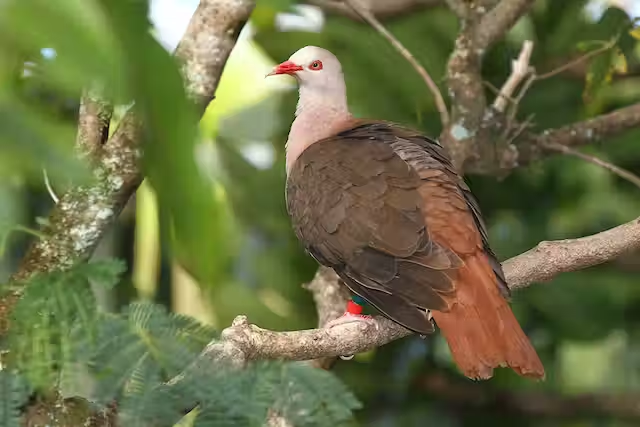
This fantastic bird is an attractive medium-sized pigeon with light pink coloured feathers on the head, neck and underparts. The forehead of the bird is white while the back is a deep brown which melts into a copper coloured tail. The females tend to be slightly duller than the males but they are both extraordinary sights for birdwatchers hoping to sight a rare bird. The tip of the bill is white while the eyes are yellow and the legs a pinkish red. Said to once be prolific the island over, these birds are now found largely in the upland forests around Black River Gorges, their decline around the island being due to deforestation and the introduction of predators such as rats, feral cats, monkeys, mongooses as well as alien plant species. These gorgeous birds are easily recognisable and if you glimpse them while on holiday in Mauritius, you can count yourself extremely fortunate.
The pink pigeon has made a remarkable comeback, with the population now numbering several hundred individuals. Thanks to these efforts, it has been downlisted from Critically Endangered to Vulnerable on the IUCN Red List, although it still relies heavily on predator control and habitat management.
3. Echo Parakeet
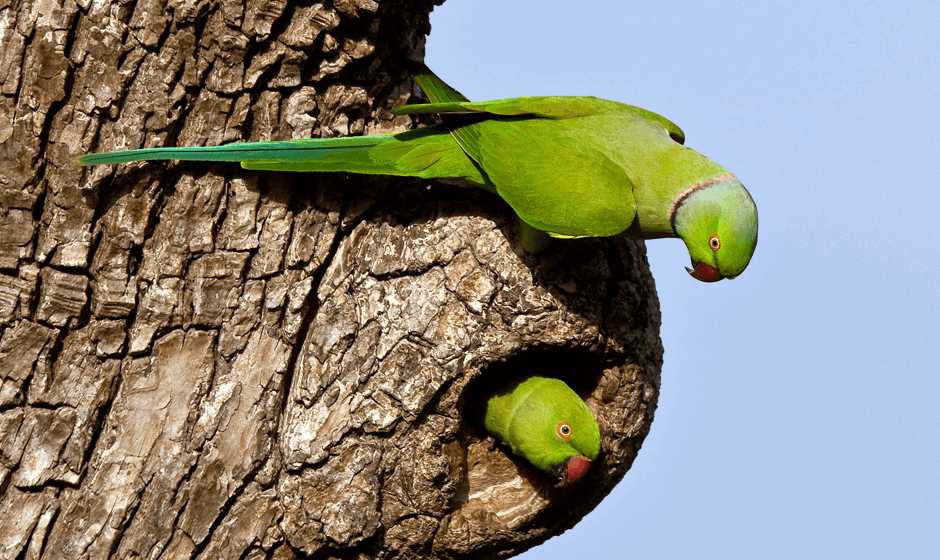
The echo parakeet, or Mauritius parakeet (Psittacula eques), is a vibrant, endemic parrot to Mauritius and is the last remaining species of Mascarene island parrots. Once critically endangered, this emerald green parrot is close both physically and in DNA to the rose-ringed parakeet, but boasts a lower-pitched call, shorter tail and deeper green coloured feathers than the latter, and are much rarer as well, only being found in the Black River Gorges area of Mauritius. The females and males differ in that the males have a marking that looks like a neck collar that the females don’t possess and red upper beaks, where the beak of the female bird is pitch black. This gorgeous parrots can grow up to 36cm in length and live on flowers, leaves and the fruit of both native and exotic plants.
Once among the rarest parrots in the world, the echo parakeet has recovered thanks to intensive conservation and is now listed as Vulnerable. Populations in Black River Gorges are stable, making it one of Mauritius’ most successful bird recovery stories.
4. Mauritius Olive White-eye
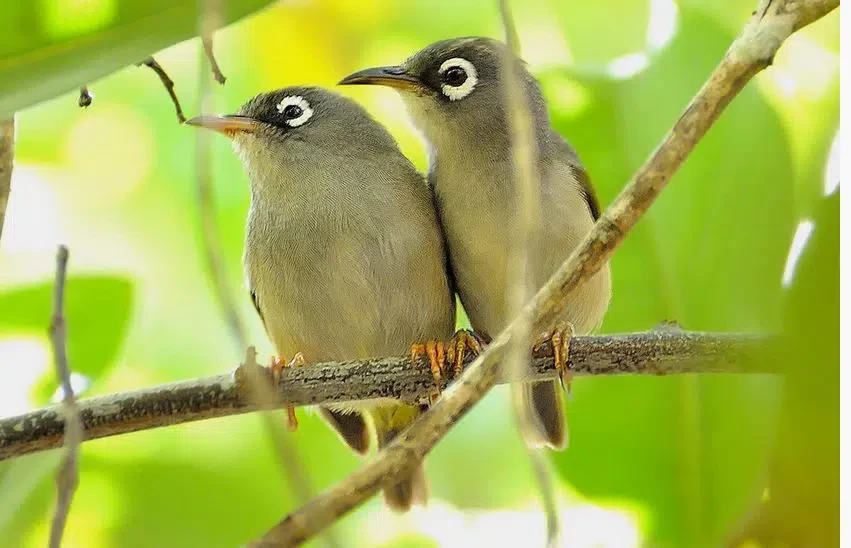
The absolutely stunning Mauritius olive white-eye joins the lists of both birds that are endemic to Mauritius and those that are endangered, and in the Mauritius olive white-eye’s case, critically so. The smallest of the Mauritian songbirds (and the least well known of them), the Mauritius olive white-eye is easily identified by the bright white circles around their eyes, a dull olive-green upper body with lighter underparts. Males and females look very similar and are small in build, reaching an average size of 10cm. These wonderful birds feed on nectar and small insects and can be found in the forested areas of Black River Gorges National Park and the Macchabée-Bel Ombre Biosphere Reserve.
It remains one of the island’s most threatened birds, with only a few hundred left in the wild. Conservation teams are focusing on protecting its breeding sites to prevent further decline.
5. Tropicbird
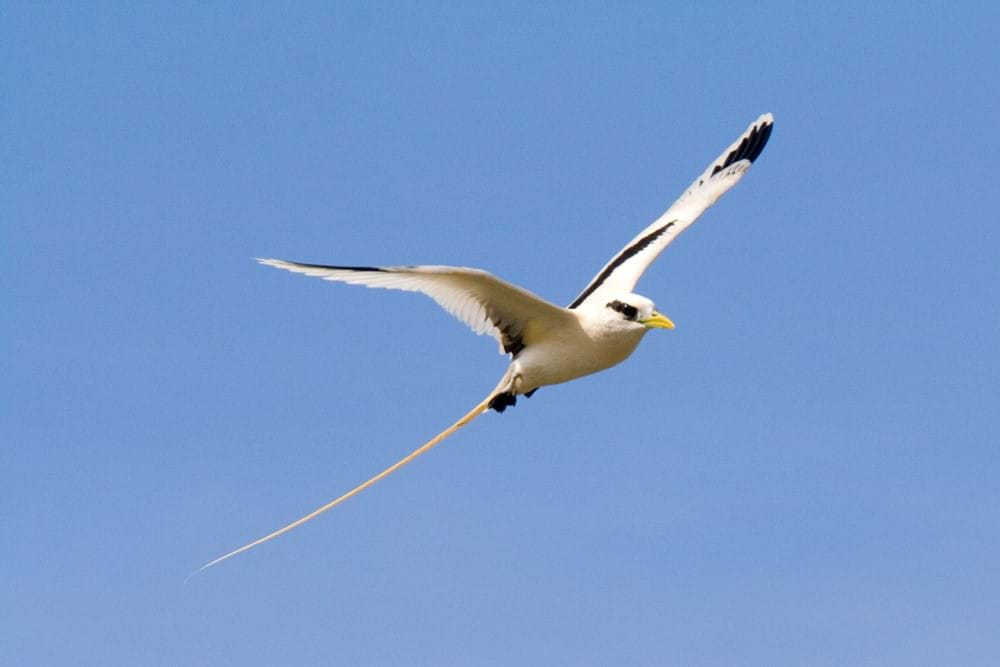
The remarkable bird that inspired the logo for Air Mauritius, the Tropicbird, or Paille-en-queue, is a gorgeous seabird found along the shores of many tropical islands and in Mauritius, you stand a chance to see both the beautiful red-tailed and the white-tailed tropicbird. These wonderful creatures are easily identified by their long, trailing tail feathers and distinctive bills (red tail feathers and red bill, and white tail feathers and yellow bills respectively). While both the red-tailed and white-tailed tropicbirds are solitary by nature, the red-tailed species is quite a bit larger with their average weight being around 800g compared to the white-tailed tropicbirds 350g. Catch these beautiful creatures gliding elegantly in phenomenal aerial displays during the breeding season.
These seabirds are still common along Mauritius’ coasts and remain cultural icons, often spotted gliding near cliffs and offshore islands. Their presence is a highlight for many birdwatchers exploring the island.
6. Mauritius Fody
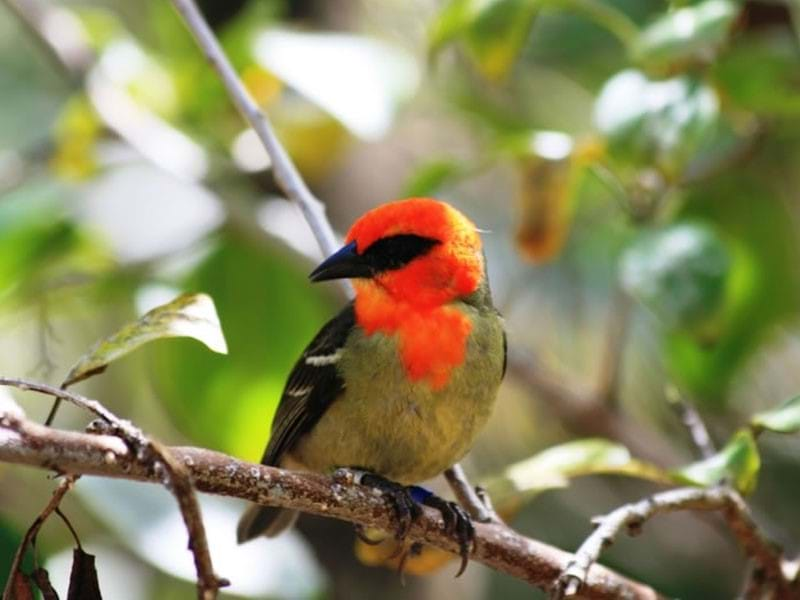
The Mauritius Fody is a small endemic songbird that at one time was extremely common in the jungle-like interiors of Mauritius and is now sadly, also endangered. It can still be sighted, if you are lucky, in the forests of the Black River Gorges National Park where the population is closely monitored. The male Mauritius Fody has brilliant red plumage from its head to its chest, with an orange patch on his rump during the breeding season. The female, in contrast, is far duller than her male counterpart, with olive-brown plumage and slightly darker wings. Both the male and the female have thin bills used to probe for insects and to feast on fruit and nectar. These delightful birds grow up to 14cm in length and, because of the red hoods on the males, are called the cardinal de Maurice in French.
It is still listed as Endangered, though populations in reserves are relatively stable. Birdwatchers continue to prize sightings of the bright red males as a highlight of any forest walk.
7. Mascarene Paradise Flycatcher
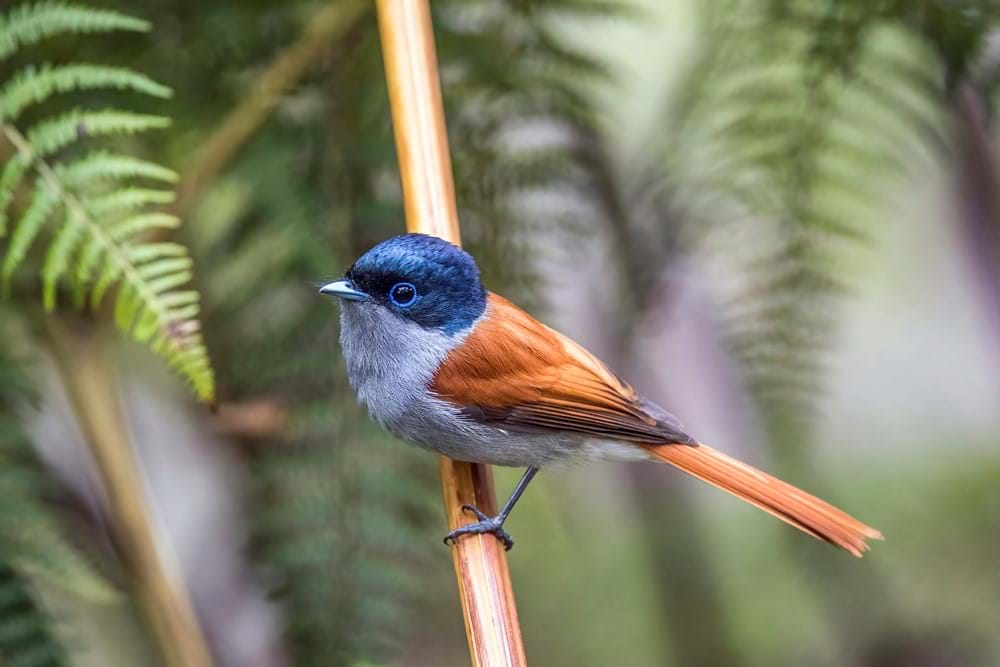
This wonderful bird is endemic, as the name implies, to the Mascarene islands of Mauritius and Reunion, each with their own subspecies, with those in Mauritius being incredibly rare and those in Reunion on the other end of the spectrum, being quite common. The paradise flycatcher found in Mauritius is overall larger and darker than the Reunion species, and has a stunning purple gloss on its head. These flycatchers don’t have the long tail usual of many other paradise flycatchers, but it’s still a wonderfully attractive bird. Measuring approximately 15cm to 20cm, the male has a blackish head with a grey band around its neck, throat, breast and belly. The upper parts are a deep chestnut and the tips of the wing are black. The bill has a bluish hue and the legs are grey. The females are very similar, but are smaller and less brilliant than the males.
In Mauritius this subspecies remains rare, and any confirmed sighting is an exciting contribution to conservation records.
If you are planning a trip to Mauritius and hope to see some of these rare endemic birds, consider a stay at one of the Sunlife resorts. Each resort is a convenient base for exploring the island and has gardens that naturally attract a variety of birdlife, allowing you to enjoy some birdwatching on the property as well. And with nearby forests and national parks also within reach, your holiday can combine relaxing moments by the beach with the chance to discover Mauritius’ unique conservation success stories.




